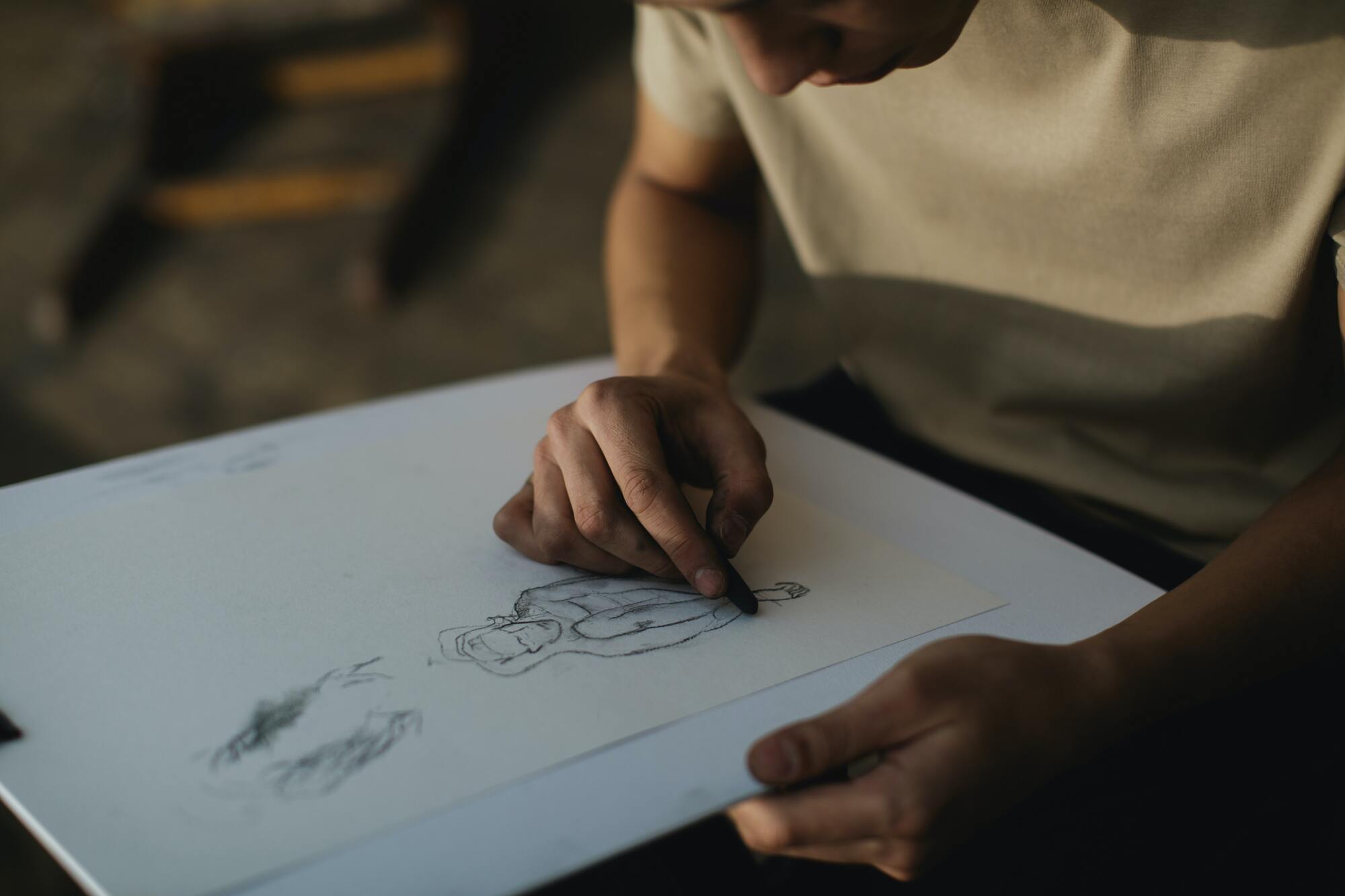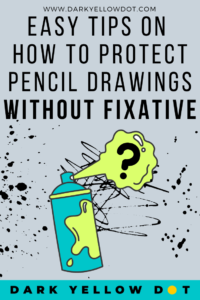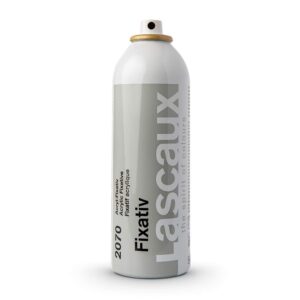


Easy Tips On How To Protect Pencil Drawings Without Fixative
How To Protect Pencil Drawings Without Fixative: The Best Options In 2022
Heads up: This post may contain affiliate links. Learn more.
Many established artists will have their own tried and tested ways of preserving pencil drawings, from professional sprays to home-made alternatives. But how do you protect pencil drawings without fixatives? Whatever method you choose; it’s an important step of the finishing process that cannot be missed.
Why is it important to protect your drawings?
There are many reasons for wanting to protect pencil drawings. Work that is delicate and prone to smudging will damage very easily when moved or stored away. This will require the artist to lock in all their marks and tones, especially in cases of soft pencil work. You may also want to fix your art during points of the drawing process, allowing work to be continued without ruining what’s already been done. In fact, there are particular professional fixatives that allow you to draw over them.
Fixing artwork is also essential to the longevity of the piece, ensuring it can be enjoyed for many years to come. Such pencil drawings commonly suffer from turning yellow over time, a natural part of the ageing process that artists like to avoid. Factors like light, dust, temperature and humidity all impact the condition of a drawing, so these need to be considered when deciding what protection method to go for. If you’re considering selling your drawings, using fixative or protection of some kind may help increase its value.
Should you use a fixative to protect your drawings?
Whether you use a spray fixative on your sketches or not is completely up to the artist and depends on the intended future of the piece. Some swear by using fixatives, as it gives added protection against damage or deterioration. Others opt to stay away, in hope of preserving the works original colour luminosity or tone depth. Either way, it can be scary to douse the painting you just spent hours on in a chemical product. But fixative or not; it’s important to take some kind of precaution when finishing your pencil drawing.
What types of fixatives are there?
If using fixative is the route you want to take, you should be aware of the different types on the market. Each with their own properties and benefits; it’s important to research and experiment with different fixative options. There is a mixture of high quality and cheaper sprays available with varying levels of quality. For maximum protection it may be worth investing in the professional product that was solely designed for drawing preservation. However, that’s not your only option. There may be products lying around your home that are equally as useful for fixing your fine art drawings.
Professional fixative sprays
Permanent fixative sprays are the kind of sealant that stops the piece being reworked, as all the marks and tones are locked in. Lascaux Archival Fix Spray is an example of this, completely sealing your work without leaving any specks or droplet marks. When using these fixatives, make sure you’re 100% finished with your drawing. How do you find these types of sprays? Normally if a product doesn’t state that it’s workable, then it’s probably going to be permanent.
Workable fixative sprays relate to the type of product that you can spray and continue to draw over. Take the Krylon K01306 Workable Fixatif Spray for example; its clear, acid free formula helps prevent wrinkling and smudging but allows you to erase through the coating to rework. This is great for artists who don’t want to smudge their hard work during the drawing process. Usually, a workable fixative spray will be labelled so.
Home fixatives
Hairspray can also be used as a fixative spray in cases where you want to save money. It works in a similar way to professional sprays, only its properties break down quicker over time. Due to this, your work is left at risk of damage and yellowing over time. However, if you’re only interested in temporary protection like students or beginners, hairspray can be a great fixative alternative. For more important and professional pieces, it may be worth investing in a better spray to preserve pencil marks for longer.
How do I use pencil drawing fixatives?
If you’re a beginner artist or have never used fixative before, you may feel apprehensive. To start with, make sure you’re in a well ventilated area as the fumes from fixative sprays are known for being unpleasant. Secondly, we recommend having a piece of paper with a graphite scribble as a tester, to see how the product comes out of the can and reacts with the paper. Sometimes the nozzle of the spray can be dried up or require a few pumps to get a clean, even spray. Use this opportunity to get your fixative spray working properly.
When you’re ready, spray the product onto the drawing surface as it’s laying flat or standing vertically. Ensure you’re not too close, standing at least a couple inches from the piece. Lastly, give it enough time to be touch-dry before storing the drawing away.
How to protect pencil drawings without fixative?
Worried about spraying product onto your drawings? The following methods explain how to protect pencil drawings without fixative at all.
In low light and humidity storage
The two main elements that you want to protect your drawings from is light and humidity, whether you’ve used fixative spray or not. Moisture in the air can be absorbed by the drawing paper, making them damp and at risk of mould. You may also notice ripples or curled edges, another sign of humidity. If you’re staying away from spray products, you’ll need to consider these factors even more so. Think about the temperature and light source of a room, cupboard or storage unit before packing away your favourite pencil sketches. Good drawing and painting storage is key to the longevity of your work.
In a glass frame
If you can’t guarantee the right environment for your graphite drawings, you should consider framing your works behind a sealed glass barrier. This protects the drawing from temperature changes, UV light and any dust particles that could form on the surface of the work. It also helps to keep your drawing flat and straight. There’s options to suit all budgets, from making your own frames to using professional framing services. If you’re thinking of selling your art, then presenting them in frames may also be the most professional way forward.
In between glassine interleaving or parchment paper
If you lack the space for multiple framed drawings, it’s possible to lay them flat on top of each other. However, make sure you insert some glassine interleaving paper or parchment paper between each piece. Ensure good contact is made between the paper and the drawing so that the graphite isn’t disturbed if the drawings are moved. This also works for drawings in sketchbooks to stop graphite transferring to the next page. As far as non-fixative methods go, this one works quite well and has an affordable option too, as waxy paper or parchment paper can be found in any supermarket.
In a photo album or portfolio
Another way of protecting your graphite sketches is by collecting them in a photo album or portfolio. For this, you’ll want to opt for an album that has plastic sleeves or page protectors, that way the surface of the drawing is being protected. When closed, the album or portfolio will shield the art from light, improving its longevity. This option may be more difficult for larger scale drawings, however there are some suitable portfolio cases on the market. It also makes storage easy, as you have all your graphite drawings tucked away in one safe place.
What is the best way to protect pencil drawings?
There is no best way of protecting your drawings as each artist has valid reasonings behind their methods. However, professional fixative sprays have been made especially to do their one job and they’re proven to be fairly good at it. That’s not to say fixative is the only answer. If you’re really needing to protect a delicate graphite drawing, pastel work or charcoal sketch – it may be wise to use a mix of multiple methods. That way, you’re making sure the art will be of good quality for years to come.
DO YOU HAVE SOME EASY WAYS TO PROTECT PENCIL DRAWINGS WITHOUT FIXATIVE? LET US KNOW IN THE COMMENTS BELOW.
Don’t forget you can always share your art with us! Become the next Artist of The Month or tag us on Instagram @darkyellowdot for a chance to be featured.
Thank you for reading and if you found this article useful, share it around, that makes us happy. To receive updates and more posts like this just join our mailing list, everyone is welcome.
NEED MORE ADVICE?
ARTICLES TO HELP:
How To Use Reference Photos For Drawing (Best Tips For Artists)
7 Drawing Pencils For Beginners That You Need To Make Beautiful Art
Lack Of Artistic Inspiration: 5 Ways To Get It Back Again
SITES TO HELP:
Winsor & Newton | Building Layers Charcoal for Density
Lascaux | Varnishes & Fixatives
COURSES TO HELP:
Charcoal Drawing Boot Camp: Tools, Techniques, Tips For Beginners
Pencil Drawing – The Fundamental Guide
Intro To Graphite Pencil Drawing





